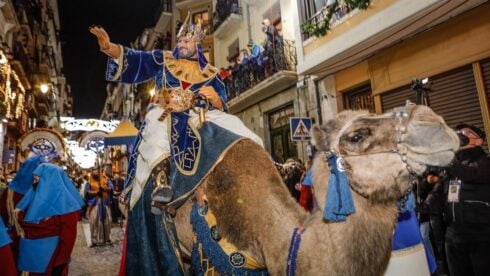
FROM the frozen wastes of Iceland to the rocky shores of Ireland and on, as the dragon flies, through Croatia, Morocco and Malta, Game of Thrones has featured dramatic landscapes and impressive architecture from all over the world.
Spain is at the top in the list of countries visited by the HBO blockbuster, and southern Spain especially has come under the spotlight.
More than ten Spanish locations appear in all eight seasons of the show, with five focused on southern Spain.
Many articles have reviewed the series’ Spanish highlights but there are other natural beauty spots and architectural wonders that Queen Cersei of the Seven Kingdoms would have killed for.
READ MORE:
- WATCH: Netflix trailer for NEW natural history series narrated by Spain’s Penelope Cruz and David Attenborough
- WATCH: Mysterious Game of Thrones-like crystal weapons from 3,500 BC discovered in Spain
- Netflix announces in-depth Maddie McCann documentary, featuring the Olive Press and ‘never before heard’ testimonies
We’ve put together a list of places we feel would have added to the stark alien beauty of Westeros and Essos. Hopefully they will inspire in your personal and creative endeavours. Who knows – you could be the next George R. R. Martin!
Fortress Malaga

Malaga is an old hand in the movie business. Its imposing Moorish walls that once protected the alcazaba (citadel in Arabic) have provided the setting for countless historical dramas and biblical epics. The ruins of a Roman Theatre still stand at the entrance to this imposing fortress overlooking the bay and downtown district. Built by the ruling Muslims in the early 11th century, it is considered a prototype of military architecture from the Taifa period, combining defensive towers and concentric walls with gardens, pools and fountains. A stone passage called the Caracho leads from the palace to the Castillo de Gibralfaro, built in the 14th century to protect the citadel.
Mezquita de Almonaster la Real,Huelva

The only remaining mosque in rural Spain, it was built by the Moors between the 9th and 10th centuries on top of a 6th-century Visigoth basilica from the 6th century and also combines Roman, Almohad and Gothic elements. After the Reconquista it was converted into a hermitage and was listed a historical monument in 1931. Today, it is principally used as a church but also doubles as a cultural centre promoting diversity and interreligious dialogue.
Santuari de Lluc, Mallorca

Founded in the 13th century, it’s said to be the most important pilgrim shrine on the island. Its location in the municipality of Escorca, surrounded by the high mountains of the Sierra de Tramuntana, makes it an ideal starting point for hikes. For a taste of life in Game of Thrones times, you can stay in the former monks’ cells – although they’re way more well-appointed these days! There’s a great botanical garden trail behind the monastery buildings.
Deia, Mallorca

Only 30 minutes north of Palma is Deia, one of the most beautiful villages in Mallorca. Located at the bottom of the Teix mountain, it is part of the Sierra de Tramuntana, UNESCO World Heritage Site since 2011. Deia’s beauty has attracted numerous artists over the years, including British writer Robert Graves who made it the setting of many of his stories. Graves is buried in the village church’s graveyard and you can visit his former house.
As well as celebrity appeal it’s a popular starting point for hikes in the mountains and trips to the beach. The two most stunning are Cala Deia, three miles from Deia by car; and Llucalcari, only accessible by foot or boat – but the wilderness Game of Thrones landscape and incredible clarity of the water make it worth the effort.
Guadalest Castle, Alicante

A bendy road from Benidorm leads to this picturesque mountaintop village 30 minutes from the Costa Blanca coast. It’s no longer a best-kept secret but the views are amazing. The castle, built by Muslims in the 11th century, can only be accessed through a 15ft tunnel hewn into the rock while the Torre de Peñon de Alcalá watchtower perched on the highest rock has become an iconic motif of the village. Commanding aerial views of the valleys and rivers below and all the way to the sea, no throne-stealing warrior hoard could hope to plan a surprise attack on this vertiginous mountain eyrie.
Ronda wonders

Ronda has a place in this list because of its dramatic views and historical charm. Many artists have waxed lyrical over the beauty of this Malaga town in Sierra de las Nieves Natural Park, including Ernest Hemingway and Orson Welles. Of its three bridges, the 18th century Puente Nuevo straddling the breathtaking El Tajo canyon and the Guadalevín river is the most impressive, and would have made a wonderful backdrop for filming. Although bullfighting wasn’t a feature of the series, the oldest bullring in Spain built in 1784 by the same architect who designed the Puente Nuevo would have made a great dragon training arena. The Ronda born torero Pedro Romero is said to have invented ‘modern’ bullfighting in the early 19th century by becoming the first to get off his horse and fight on foot.
Butron Castle, Gatika

Butrón Castle transports visitors to the Middle Ages, when it was continuously fought over by rival families…Sound familiar? Located on a hill in Gatika in the Basque Country, the unique fortress is surrounded by a 100-year-old forest and could have easily been the backdrop of another Lannister-Stark feud.
In fact for hundreds of years, the castle was the cause of non-stop warring between two sides of Bizkaia’s nobility, with the Lords of Butron holding fort.
The castle was abandoned in the 16th century before being restored some 300 years later.
Loarre Castle, Huesca

This majestic 11th-century fortress in the province of Huesca, Aragon is considered to be Europe’s best-conserved Romanesque castle.
Sitting up on a rocky ridge 1,071 metres above sea level it was highly important to King Sancho III the Elder in the Christian Reconquest from the Moors. Together with nearby Marcuello castle, both were strategically significant in the Aragonese defence system against the iron strength of the Moors in Bolea.
Although it didn’t make the Game of Thrones cut the castle did feature in Ridley Scott’s 2005 epic, Kingdom of Heaven.
Segovia Alcazar

A castle fit for a princess or the fair Daenerys, this famous fairytale fortress an hour from Madrid was rumoured to be the inspiration behind Cinderella’s Castle in Walt Disney World.
It stands on an imposing rock promontory shaped like the bow of a ship. This rocky outcrop has been shaped, over time, by the waters of the Rio Eresma, which flow around it and a walk along the Camino de la Cuesta de los Hoyos below it reinforces the illusion that the castle is sailing towards you.
Olvera Castle, Cadiz

Commanding 360 degree views and perfect for frontier defence, the Moors first built this castle in the 12th century to defend the border of the Nasrid Emirate of Granada against the Spanish Kingdom of Castile. Around it, the medieval town of Olvera grew.
In 1327 it was taken by the King of Castile, Alfons XI. The Christians then completely rebuilt the castle into the stalwart fortress we see today.
Almodovar del Rio Castle, Cordoba

Visible for miles around, it perches atop a sheer-walled monolith, lording it over the town of Almodovar del Rio and the Guadalquivir Valley. It has had many loving owners, hence its reputation as one of the best-preserved castles in Spain.
Originally a Roman fort, rebuilt by the Moors in 760 and reclaimed by the Christians in 1240, under Pedro I and Enrique II it was done up as a royal residence. Later the fortress was handed to the knightly order of Calatrava and then on to the order of Santiago. Finally, in 1903, then-owner the Earl of Torralva began a restoration project that took until 1936 to complete. This castle was built to last – perfect for withstanding attack from battling warlords and fire-breathing dragons.
Besalu, Catalunya

This stunning town has kept much of its medieval structures in tact so the set designers could take a well-earned break. The fortified citadel is laced with narrow cobbled streets that link to its iconic medieval bridge which is spectacularly illuminated at night.
Click here to read more Spain News from The Olive Press.









Not sure thats the Alcazar in Segovia in the pic. And the pic of the Aldomovar Castle is a close up shot of the same pic of Guadalest